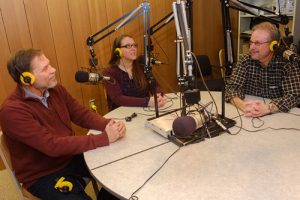Initiatives for the Long Game

Barry D. Nussbaum
As president of the American Statistical Association, I have the task of developing new initiatives. In fact, upon learning I was elected president, several members immediately asked me, “What are your initiatives?” So, let me set the record straight. Yes, presidents are expected to establish initiatives, but I regarded this as more of an opportunity. This is the chance for me to offer activities I think the ASA should be doing anyhow and should be doing permanently.
I think many other presidents have had the same concept, but it is worth stating explicitly. Frankly, I also know some prior presidential initiatives that did not last permanently … and these usually get named for the president that endorsed them. It is somewhat like the Affordable Care Act. If you like the program, you call it “affordable care.” If you don’t like it, you call it “Obamacare.” So, here’s hoping we remember and continue the initiatives and not necessarily that I was the guy who started them.
What are these initiatives? They are in the fields of communications, youth, and engagement of our largest growing professional sector.
Communications

Photo courtesy of Scott Kissell, Miami University
At Miami University, John Bailer, head of the statistics department (left), and Richard Campbell, chair of the media, journalism, and film department (right), record the Stats + Stories podcast with moderator Rosemary Pennington of the department of media, journalism, and film.
For years, statisticians have had courses and seminars aimed at improving our communications so our studies, procedures, and results are better understood. However, this may not be enough. Some of you have heard my mantra, “It is not what we said; it’s not what they heard; it’s what they say they heard.” I think we have done a great job at the first element and a decent job at the second, but there is much to do to ensure they understand and implement what we have produced.
This comes from my years as chief statistician of the U.S. Environmental Protection Agency. That job required me to work in collaboration with scientists, analysts, policymakers, economists, lawyers, etc. I had to make sure the statistical results would be properly integrated into policy, regulation, and enforcement actions.
I am delighted that some inroads have already been made in ensuring the recipient truly gets the message. I have been impressed with the Stats + Stories program at Miami University in Oxford, Ohio. John Bailer, head of the statistics department, teamed up with Richard Campbell, head of the media, journalism, and film department. They have developed audio podcasts in which a statistician is quizzed by a journalist and a statistician. Their maxim is “The Statistics Behind the Stories and the Stories Behind the Statistics.”
This is precisely the interaction between statistics and real problems that has to be emphasized. The messages received by the public are enhanced if the statisticians communicate the analyses in an understandable manner and the reports accurately and succinctly include the pertinent data and statistics. For full disclosure, I was the guest statistician on Stats + Stories last April in a segment discussing environmental protection, titled “A Statistician Clears the Air.” (Yes, I love double entendres.)
Rather than reinventing the wheel, we are teaming up with Miami University to create a national profile for Stats + Stories while supporting the ASA’s initiative to be the “Face of Statistics.” Activities include joint editorial discussions concerning the selection of topics and presenters, increasing the production schedule to include monthly podcasts, introducing biweekly short Stats + Stories, and reducing the time between interview and release to ensure more timely podcasts.
I am delighted that Donna LaLonde of the ASA staff is leading this effort, signifying, among other things, the ongoing nature of this initiative. Share story ideas or suggest potential guests for the Stats + Stories podcast.
Youth
In an effort to promote our profession to young folks, I think we have to go earlier and earlier into their school awareness. While progress has been made at all levels of K–12 and in describing a model statistics undergraduate curriculum, I think some quick internet snapshots might intrigue the youth, perhaps at the middle-school level. These one-minute animations, cartoons, discussions, etc.,—all with the goal of piquing a young person’s interest in statistics—would be called “Stat Shots.”
The impetus for this was my trip a few years ago to the Museum of Mathematics in New York City. I watched in amazement while young children were intrigued by mathematical concepts. They didn’t even think of it as “learning.” It surely was motivational to them. But, alas, there was nothing about statistics in the mathematics museum. To fill this void, did we need our own museum? Try as I did, the ASA did not seem interested in erecting a brick and mortar statistics museum. But, the ASA will be establishing a virtual museum for statistics, tentatively called the “House of Statistics,” to produce first-class, intriguing products. A task group, including ASA staff members, has been assembled to suggest topics, view similar content already on the web, and develop initial examples. The staff have already identified many websites with applicable content. With suitable arrangements, these can be included in the ASA’s House of Statistics.
Engagement
It is quite apparent that while we are the American Statistical Association, many members come from other countries. I have observed that these members frequently give papers at JSM, but are not as active in the inner workings of the ASA, such as belonging to sections, chapters, and committees. The fastest-growing segment of our profession (and the predominant segment of statistics departments in the United States) consists of Asian statisticians. So, I established an initiative, which some have called the “Asian Initiative,” that seeks to address the needs of Asian students and young professionals.
To that end, we have established a joint task force with two representatives each from the International Chinese Statistical Association, International Indian Statistical Association, and Korean International Statistical Society, as well as one appointed by the ASA. We have asked those three organizations to invite a younger colleague who is active and involved enough to have a good sense of what Asian students and early-career professionals are thinking about. We are especially interested in differences in cultures or customs that might affect their involvement in statistical societies. The purpose of this task force is to determine the needs of Asian statisticians as they prepare for and enter the profession, with a view to their success as professionals and their ongoing involvement in our societies.
We are undertaking this initiative since we firmly believe active participation in the professional society proves mutually beneficial to the individual statistician, the society, and the profession as a whole. We would like to work together to make recommendations for our societies to attract and retain young Asian members.
The task force is charged with gathering information as directly as possible from students and early-career professionals—and those who are in a position to influence them—about their interests and needs and to make recommendations based on that information. As a measure of how seriously I view this initiative, I asked 2015 ASA President David Morganstein to chair the task force.
I am convinced that successful efforts on these initiatives will serve to enhance the ASA and our entire profession. Let me repeat, however, that I do not intend for these to be one-year efforts. My belief is that the ASA should sustain these efforts long after I stop writing this column. Since these are multi-year, it means more people than just the initial task forces will be involved. That invariably means you. So, please don’t just regard these as a passing fad. Join in and help make them successful sustained efforts.
Significantly forward,
Barry

















